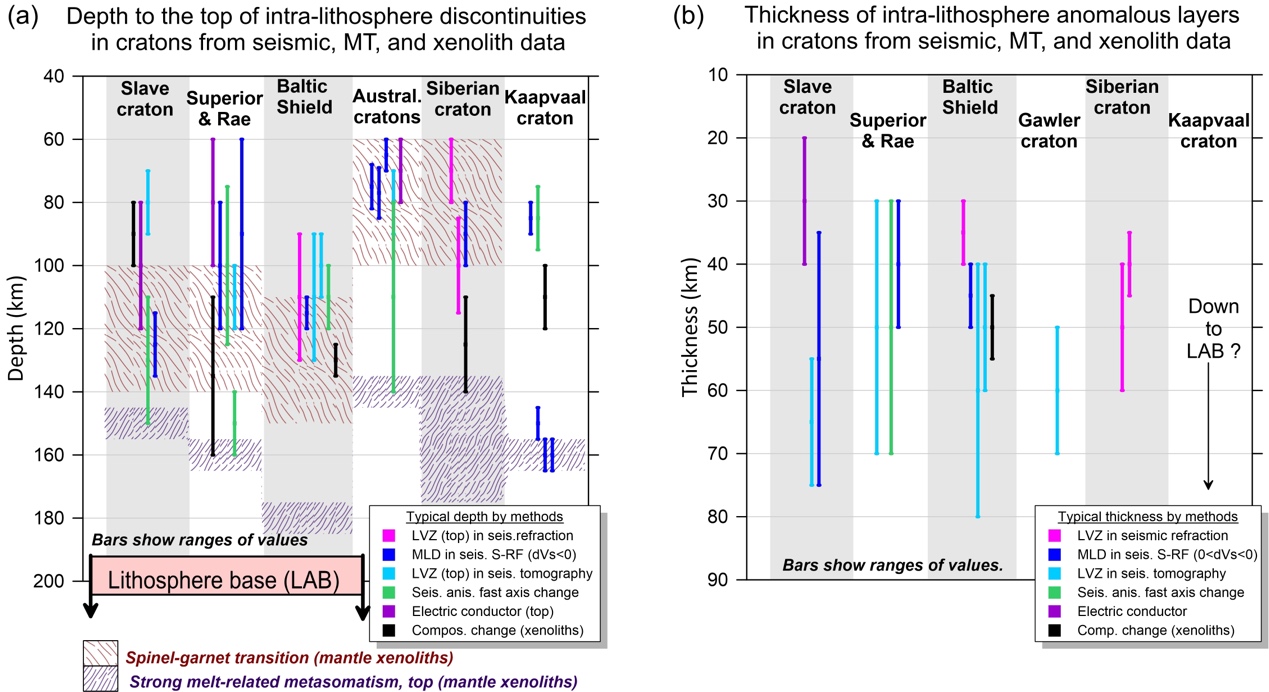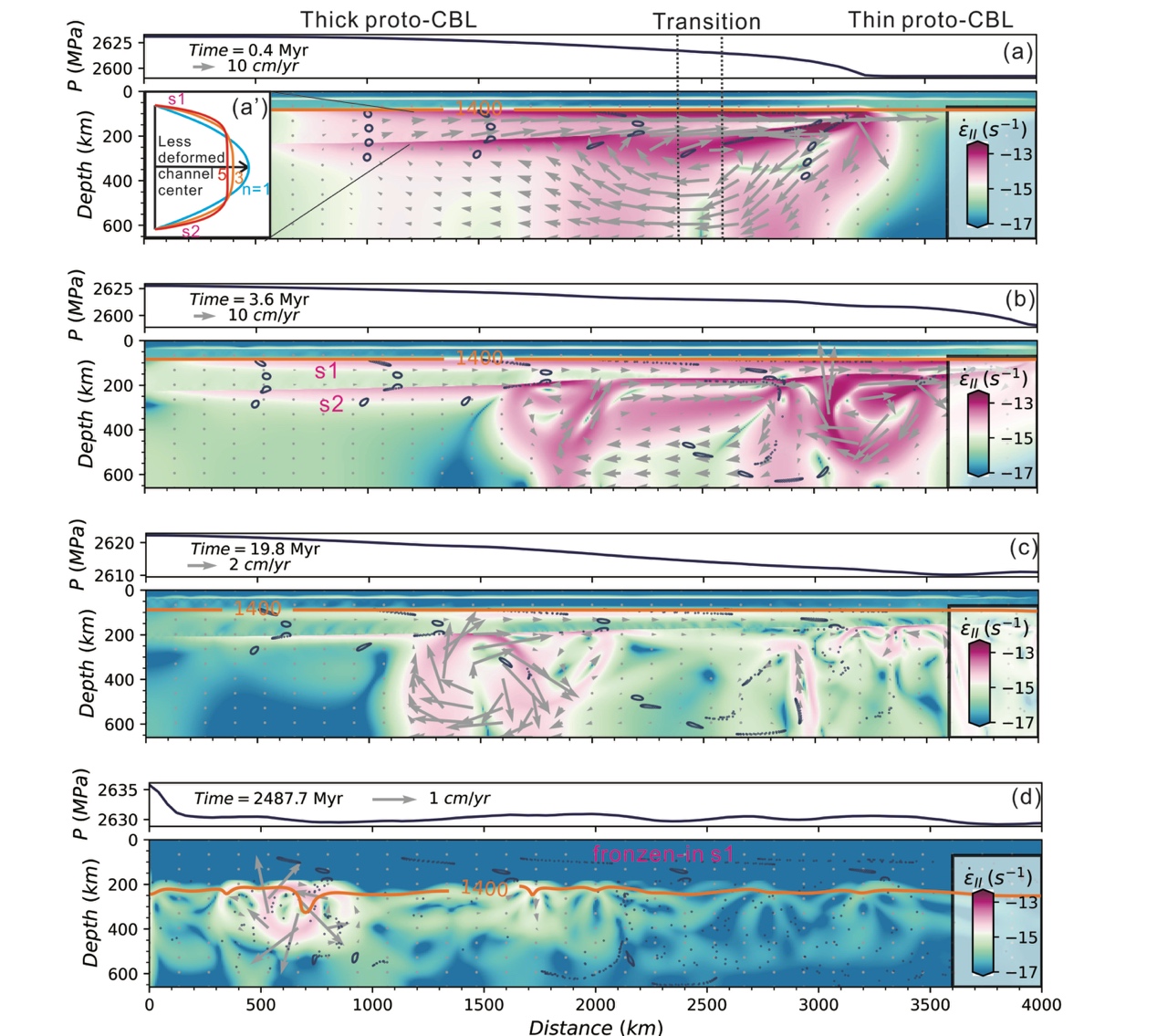Editor: 谢佳 Author: Time: 2023-10-25 Number of visits :208
Stable cratons with a thick (> 200 km) and cold lithosphere form rheologically strong plates that move atop a ductile asthenospheric mantle. Various types of seismic observations show the presence of a potentially rheologically weak zone at depths of ca. 80 – 150 km termed the Mid-Lithosphere Discontinuity (MLD) (Fig. 1).

Figure 1. Compilation of depth to intra-lithosphere discontinuities in cratons (a) and thickness of the anomalous intra-lithosphere layer below these discontinuities (b) from seismic, MT, and xenolith data.
While various mechanisms may explain the MLD, the dynamic processes leading to the seismic observations are unclear. We propose that the MLD can be caused by channel flow in the lower lithosphere, triggered by negative Rayleigh-Taylor instabilities at cratonic margins in the Archean, when the mantle was hotter than at present (Fig. 2). Presence of a chemically distinct, low-density cratonic lithospheric root is required to initiate the process.

Figure 2. Initial setup of the end-member model, which includes a thick proto-lithosphere (x = 0–2,400 km) and a thin proto-lithosphere (x = 2,600–4,000 km) area with a linear transition between the two domains. (a) The model includes three layers: crust—top 40 km; mantle chemical boundary layer (CBL) with the base (chemical LAB, CLAB) at a depth of 235 km in the thick domain and 95 km in the thin domain, underlain by asthenospheric mantle down to 660 km depth. Circular markers in the upper half of the model (at x = 500–3,000 km) trace mantle deformation. (b) Initial in situ density profiles at thick (x = 2,300 km, blue) and thin proto-lithosphere domain (x = 2,800 km, red). In the sub-lithospheric mantle, a temperature-controlled density decrease with depth leads to convective instability (gray arrows). The lithostatic pressure difference between the two profiles is illustrated by the orange line. (c) Initial temperature profile at time zero with a linear temperature increase from 0°C at the model top to a potential temperature of 1,500°C at depth 90 km (thermal LAB, TLAB), with further increase in deeper mantle with an adiabatic gradient of 0.3°C/km.
Numerical modeling shows that the top of the channel flow creates a shear zone at a depth comparable to the globally observed seismic MLD. Grain size reduction in the shear zone and accumulation of percolated melts or fluids along the channel top may reduce seismic wave speeds as observed in the MLD, while the channel flow itself may explain radial anisotropy of seismic wave speeds. Secular cooling of the Earth deepens the top of the channel flow on a 1 Gyr scale, and early-stage large-scale (1000’s km long) channel flow deformation switches to a different deformation style with a smaller (100’s km) wavelength. These multiple convection cells with alternating upwelling and downwelling may reduce the strength of radial anisotropy caused by large-scale channel flow in shallow proto-cratonic lithosphere (Fig. 4)

Figure 3. Snapshots of the end-member model state after 0.4 Myr (a), 3.6 Myr (b), 19.8 Myr (c), and 2487.7 Myr (d). Snapshots show the square root of second invariant strain rate. Pressure P profiles at depth of 90 km are plotted above each time snapshot. Gray arrows show velocity of material motion (scale shown above each snapshot); Orange lines—temperature isotherm of 1,400°C, which closely follows the TLAB. (a) Convective instability at the thick proto-CBL domain edge produces a low-pressure zone to the right of the thick domain. It drives the rheologically weak, high-temperature chemical lithosphere root toward the thin proto- CBL region, thus forming a continuous channel flow over a few thousand kilometers distance. (b) In the thick proto-CBL domain, the channel flow forms one strong shear zone (labeled s1) within the chemical lithosphere at a depth of ∼100 km and another (labeled s2) at the top of the sub-lithospheric mantle. (c) The driving pressure gradient in the channel decreases in magnitude with time, reducing the intensity of the channel flow. (d) After ∼2.5 Gyr of model evolution, TLAB has deepened to ∼220 km depth; shear zone s1 is preserved as frozen-in strain at mid-lithosphere depths, while the sub-lithospheric shear zone s2 is destroyed by the underlying mantle convection.

Figure 4.Sketch (not to scale) illustrating mantle evolution through time from a newborn thick cratonic lithosphere to the present. It shows how the footprints of the once existing channel flow structure (black dots) remain preserved in the present mid-lithospheric mantle. Secular cooling of the Earth's interior leads to a change in the upper mantle convection style and its interaction with the cratonic chemical boundary layer (lithospheric root). LAB—lithosphere-asthenosphere boundary, TLAB—thermal LAB, CLAB—chemical LAB.
Haibin Yang, the first author and the corresponding author of this paper, is now an assistant Professor at School of Earth Sciences, Zhejiang University. This research was funded by the National Natural Science Foundation of China (Grant No. 92055210) and partially supported by the MOST special funds of China for GPMR State Key Laboratory (GPMR2019010).
Article information: Yang, H., Artemieva, I. M., & Thybo, H. (2023). The mid-lithospheric discontinuity caused by channel flow in proto-cratonic mantle. Journal of Geophysical Research: Solid Earth, 128, e2022JB026202. https://doi. org/10.1029/2022JB026202
